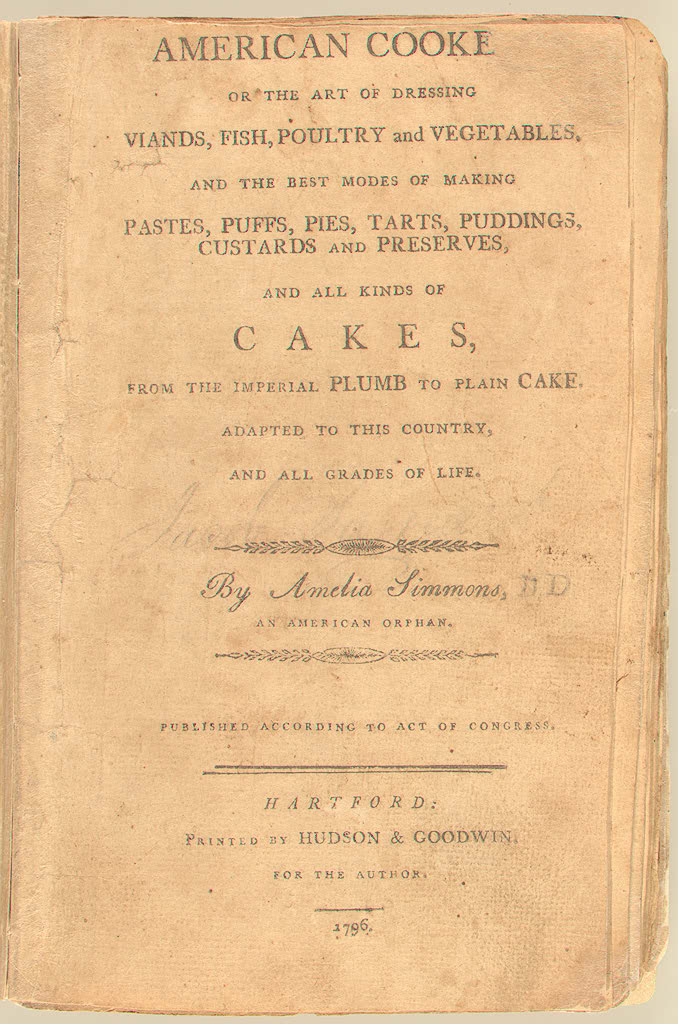Book 1: The First American Cookbook, 1796

Alt Text: We see an old, yellowed paper. On it is printed in light brown the title of the book, author’s name, place of publication and year. It is very plain with no images.
The First American Cookbook by Amelia Simmons; Mary T. Wilson (Introduction by)
Call Number: TX703 .S5 1984b (available in NYU Special Collections)
ISBN: 0486247104
Publication Date: 1984-10-01
Description: “Exact reproduction of the first American-written cookbook published in the United States. Authentic recipes for colonial favorites -- pumpkin pudding, winter squash pudding, spruce beer, Indian slapjacks, and more. Introductory essay and Glossary of colonial cooking terms.”
In 1796, Ammelia Simmons published her book American Cookery, or the art of dressing viands, fish, poultry, and vegetables, and the best modes of making pastes, puffs, pies, tarts, puddings, custards, and preserves, and all kinds of cakes, from the imperial plum to plain cake: Adapted to this country, and all in Hartford, Connecticut. This is the first compendium of American recipes by an American. Also a note on this specific edition that I’ve linked above—this is a modern reprint and much of the instructions are different from the original copy as it has been adapted for a modern audience.
Why does this belong in our library?
This is the first American cookbook and the author was a woman who published in her own name. Compare it to Frankenstein by Mary Shelley, which was published anonymously in 1818—22 years after Amelia’s book.Its long title is something we would not see in a modern book, but was characteristic of a certain time in publishing.The book gives us indirect knowledge of the culture of the times. Think about what kitchen equipment they had? Obviously there is no mention of something like a stand mixer or even an oven.The book shows the inexactitude of cooking in the past. Her recipes use less standardized measurements than a modern cookbook and the ones she provides are usually different than what we would use today.The book gives clues as to what some of the Indigene ate, but should be taken with caution. The Word “Indian” appears several times throughout the book, but is unclear whether or not it’s the descriptions are in reference to what Indigenous people consumed or if it is just how this cuisine was perceived through a White European colonial lens. This information is still valuable in that it tells what those perceptions were.The books provides inferences about American foodways during that time. The most interesting recipe might be “How to dress a turtle”. This is a literal turtle (as opposed to something like a chocolate turtle which contains no actual turtle, by the way). So, Americans at the time apparently ate turtle meat and it was worthy enough to include a surprisingly detailed recipe. Simmons also provides recipes for “goslin” (gooseling) and “water fowl”. She provides variations of her recipes. For example, she has four recipes for a butter cake. In many of her recipes, she uses nutmeg which was ubiquitously used at the time. While we still use it in recipes today, it is much less common. What other ingredients in the past might have been lost due to a changing American palate?The book also holds linguistic value in seeing what things were called or how certain words were spelled. e.g. “pompkin” pie (video below); “Cookey” instead of cookie, from a Dutch word; “Whipt” instead of whipped; “Alamode” instead of the usual a la mode; “Paste”—a common word for the time, referring to what we could call dough or batter (for example: her “puff paste for tarts” recipe). Recipes can also be seen in French and Italian with the still common use of the words pâte and pasta. For example pâte à bombe, pâte brisée or pasta frolla
Things to keep in mind:
No pictures! Obviously this was more difficult to do at the time. But, if we want to use this practically, and actually make a recipe out of the book, having a visual component is really important—especially for homecooks.Recipes are short with little detail. They include very few standardized measurements, imprecise baking times and temperatures. Much of this book relies on the reader having an already strong grasp of kitchen knowledge. Additionally, ingredients and their amounts are written within the text. A modern cookbook today would list ingredients and amounts separately from the instructions. There is no aesthetically pleasing cover. When we fill up our libraries with books, we want something beautiful to display, and this doesn't help.The title is too long. It is shortened to “American Cookery”, but this is only part of the actual title.It's better for historical context, rather than a modern cookbook that would make me want to use a recipe from it. But that’s okay! This is what gives it such value.
What I recommend you make:
Pound cake, Independence cake, Molasses Gingerbread, or buttery “cookey”.
Other Resources:
Videos:
Pumpkin Pie from 1796 - A History of Pumpkins (YouTube Video 18 minutes 58 seconds)
This meticulously researched youtube channel is organized by Max Miller. It is a great food history resource with recipes, methods adopted for modern kitchens, large scope in recipes made. Miller makes one of Ammelia’s “pompkin” pie recipes, so we can see this hundreds of years old recipe being made. How does this compare to a recipe your family might make for Thanksgiving?
Further Reading:
What America’s First Cookbook Says About Our Country and Its Cuisine
Ox Tales Podcast on Why Kitchen Technology Matters